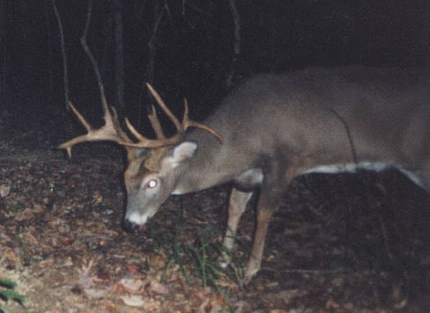
A white-tailed buck fortunate enough to have survived multiple brushes with death over the course of several hunting seasons understands that it can avoid danger by simply avoiding daylight altogether. Severe hunting pressure promotes nocturnal behavior in whitetail bucks – plain and simple. So how can savvy hunters with the desire to pursue whitetail bucks late in the season cope with this seemingly impenetrable nighttime armor?
For just a moment, put yourself in the position of a mature buck. Over the course of the last three, four, maybe even 5 years, he’s likely covered every square-inch of his home range. At one time or another, the buck has encountered humans during daylight hours, or at least detected human scent.
It is quite possible that a mature whitetail can recall areas where he previously encountered humans or their scent. Afterward, it will purposely avoid those areas during daylight. However, I’m willing to bet that mature bucks simply find comfort in thick cover and undisturbed areas where human scent is rarely encountered, if ever. Also, thick bedding areas are where bucks can easily hear an intruder approaching. Any area with good vantage points further intensifies their desire to bed and lay low.
Contrary to what some might think, even mature whitetails displaying the most extreme nocturnal behavior don’t simply find a nice place to lay up and sleep the day away. Even at the very least, a deer must take periodic breaks throughout the day to answer nature’s call.
One study conducted during the winter found white-tailed deer will take as many as 22 such breaks a day! This means that during daylight hours, you can expect a buck to get up and move around approximately 10 times. Whitetails typically stand at these times and generally travel at least a few feet from their previous bed before lying down again.
In addition, though mature bucks’ major foraging activity often occurs under the cover of darkness, they’ll take advantage of these two-minute daytime bathroom breaks to stretch their legs, browse on available vegetation or mast and, depending on the time of year, rub their antlers on a small tree or two before bedding down once more.
Over the course of a day, and after 10 or so repeated episodes, a buck may move 100-yards or more, depending on the size and shape of the cover available.
Late in the season, mature white-tailed bucks may not move much during daylight hours, but they do move. So remaining vigilant and hunting hard is the ticket.

How often do you think a mature buck 4 1/2 to 5 1/2 will check his scrape line.
A buck will check his scrapes often when anticipating the rut, sometimes daily. After he pairs up with a doe, however, he may not check his scrapes for days. It depends on the number of does in the area as well as the individual buck.
I have hunted scrapes for a long time and have had the best luck by finding a buck’s routes of travel to and from the scrape. I have found that bucks will commonly use vantage points to bed where the wind changes direction morning and mid-day. This allows him some rest and an ability to be well hid, yet the wind lets him know if any does have marked his scrap.
However, this year I have found a incredible number of scrapes on a set of logging roads running parallel to one another. These roads are at least 1 mile long each and every 100 yards or more there are scrapes on each one. It is simply an incredible amount of scrapes!
So one would think set up a blind or tree stand somewhere in the middle, wait, and hope. So where is this buck or bucks? In a swamp or on a plateau up wind in the morning and down wind in the late day. Every time I attempt a 4 hour long sneak ambush…. there the buck goes!! On the other side. One explosive jump and gone.
Makes me growl, then smile every time. He’s a shooter…. and a great opponent. Though he probably doesn’t feel this respect for me, I do for him. One of us will die of old age before we give up. Hope it’s me.
Aim small , miss small. You all have a good hunt. Sincerly yours–
Richard W. Baril, Haverhill NH
Excellent report on mature bucks. We purposely hunt the perimeter of our property to allow the deer to feel safe on the inside bedding cover. It makes it tough at times to see the old, mature bucks because we know they are bedded during daylight. Occasionally, one will move as the writer reports or a buck will enter our land from an adjacent property where he was pushed off by still hunters. It takes discipline and patience to not to shoot at young bucks while waiting for the mature bucks to make a mistake.
Thanks for the great tips on hunting big mature dominant bucks because I know of about 2 or more bucks that I hope I will have an encounter on this year